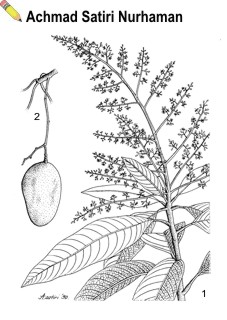Record Number
4410
PROSEA Handbook Number
5(2): Timber trees; Minor commercial timbers
Taxon
Mangifera laurina Blume
This article should be read together with the article on the genus: Mangifera (timber aspects) in the Handbook volume indicated above in this database.
This article should be read together with the article on the genus: Mangifera (timber aspects) in the Handbook volume indicated above in this database.
Protologue
Mus. Bot. Lugd.-Bat. 1: 195 (1850).
Synonyms
Mangifera longipes Griffith (1854), Mangifera parih Miq. (1859), Mangifera sumatrana Miq. (1859).
Vernacular Names
Indonesia: mangga parih (West Java). Malaysia: manga aer (Sabah). Philippines: apali (Tagbanua). Burma (Myanmar): thayet-pya. Thailand: mamuang-kaleng.
Distribution
Peninsular Malaysia, Sumatra, Java, Borneo, the Philippines (Palawan), also in Burma (Myanmar), Indo-China, Thailand and possibly in Sulawesi; sometimes also cultivated around villages.
Uses
The wood is used as machang. The fruit has only a small amount of flesh which liquifies at maturity, so that it can be sucked out. More often the immature fruit is sliced and served in fruit salads with a spicy sauce ('rujak').
Observations
A medium-sized to fairly large tree up to 36 m tall, with bole up to 100 cm diameter, bark surface longitudinally cracked, peeling off in small, narrow strips, pinkish-brown to blackish; leaves oblong to lanceolate-oblong or elliptical-lanceolate, (6—)14—30 cm (2—)3—7 cm; inflorescence pseudo-terminal, lax and widely pyramidal, apically sparingly, minutely puberulous; flowers 5-merous, petals 3.5—5.5 mm long, whitish-green to pale yellowish, with 3—5 ridges on the inner surface, extending half-way along the petal and confluent at base, disk fleshy, 5-lobed, cup-shaped, one stamen fertile, free, staminodes minute; fruit usually obliquely subglobose to oblong-ovoid, up to 10 cm long, yellowish-green when ripe. Mangifera laurina occurs in lowland evergreen rain forest up to 150 m altitude. The heartwood is reported to be greyish to pale red but also chocolate brown; the density of the wood is 690—790 kg/m3 at 15% moisture content. See also the table on wood properties.
Image
 | Mangifera laurina Blume – 1, flowering twig; 2, branchlet with fruit. |
Selected Sources
[77]Burgess, P.F., 1966. Timbers of Sabah. Sabah Forest Records No 6. Forest Department, Sabah, Sandakan. xviii + 501 pp.
[162]Flora Malesiana (various editors), 1950–. Kluwer Academic Publishers, Dordrecht, Boston, London.
[328]Kostermans, A.J.G.H. & Bompard, J.-M., 1993. The mangoes. Their botany, nomenclature, horticulture and utilization. International Board for Plant Genetic Resources and Linnean Society of London. Academic Press, London. 233 pp.
[388]Lopez, D.T., 1982. Malaysian timbers – machang. Malaysian Forest Service Trade Leaflet No 68. Malaysian Timber Industry Board, Kuala Lumpur. 8 pp.
[414]Meniado, J.A. et al., 1975–1981. Wood identification handbook for Philippine timbers. 2 volumes. Government Printing Office, Manila. 370 pp. & 186 pp.
[474]Oey Djoen Seng, 1951. Perbandingan berat dari jenis-jenis kaju Indonesia dan pengartian beratnja kaju untuk keperluan praktek [Specific gravity of Indonesian woods and its significance for practical use]. Laporan No 46. Balai Penjelidikan Kehutanan, Bogor. 183 pp.
[673]Verheij, E.W.M. & Coronel, R.E. (Editors), 1991. Plant resources of South-East Asia No 2. Edible fruits and nuts. Pudoc, Wageningen. 446 pp.
[162]Flora Malesiana (various editors), 1950–. Kluwer Academic Publishers, Dordrecht, Boston, London.
[328]Kostermans, A.J.G.H. & Bompard, J.-M., 1993. The mangoes. Their botany, nomenclature, horticulture and utilization. International Board for Plant Genetic Resources and Linnean Society of London. Academic Press, London. 233 pp.
[388]Lopez, D.T., 1982. Malaysian timbers – machang. Malaysian Forest Service Trade Leaflet No 68. Malaysian Timber Industry Board, Kuala Lumpur. 8 pp.
[414]Meniado, J.A. et al., 1975–1981. Wood identification handbook for Philippine timbers. 2 volumes. Government Printing Office, Manila. 370 pp. & 186 pp.
[474]Oey Djoen Seng, 1951. Perbandingan berat dari jenis-jenis kaju Indonesia dan pengartian beratnja kaju untuk keperluan praktek [Specific gravity of Indonesian woods and its significance for practical use]. Laporan No 46. Balai Penjelidikan Kehutanan, Bogor. 183 pp.
[673]Verheij, E.W.M. & Coronel, R.E. (Editors), 1991. Plant resources of South-East Asia No 2. Edible fruits and nuts. Pudoc, Wageningen. 446 pp.
Author(s)
R.H.M.J. Lemmens
Correct Citation of this Article
Lemmens, R.H.M.J., 1995. Mangifera laurina Blume. In: Lemmens, R.H.M.J., Soerianegara, I. and Wong, W.C. (Editors): Plant Resources of South-East Asia No 5(2): Timber trees; Minor commercial timbers. PROSEA Foundation, Bogor, Indonesia. Database record: prota4u.org/prosea

All texts are licensed under a Creative Commons Attribution-Noncommercial-Share Alike 3.0 Netherlands License
This license does not include the illustrations (Maps,drawings,pictures); these remain all under copyright.